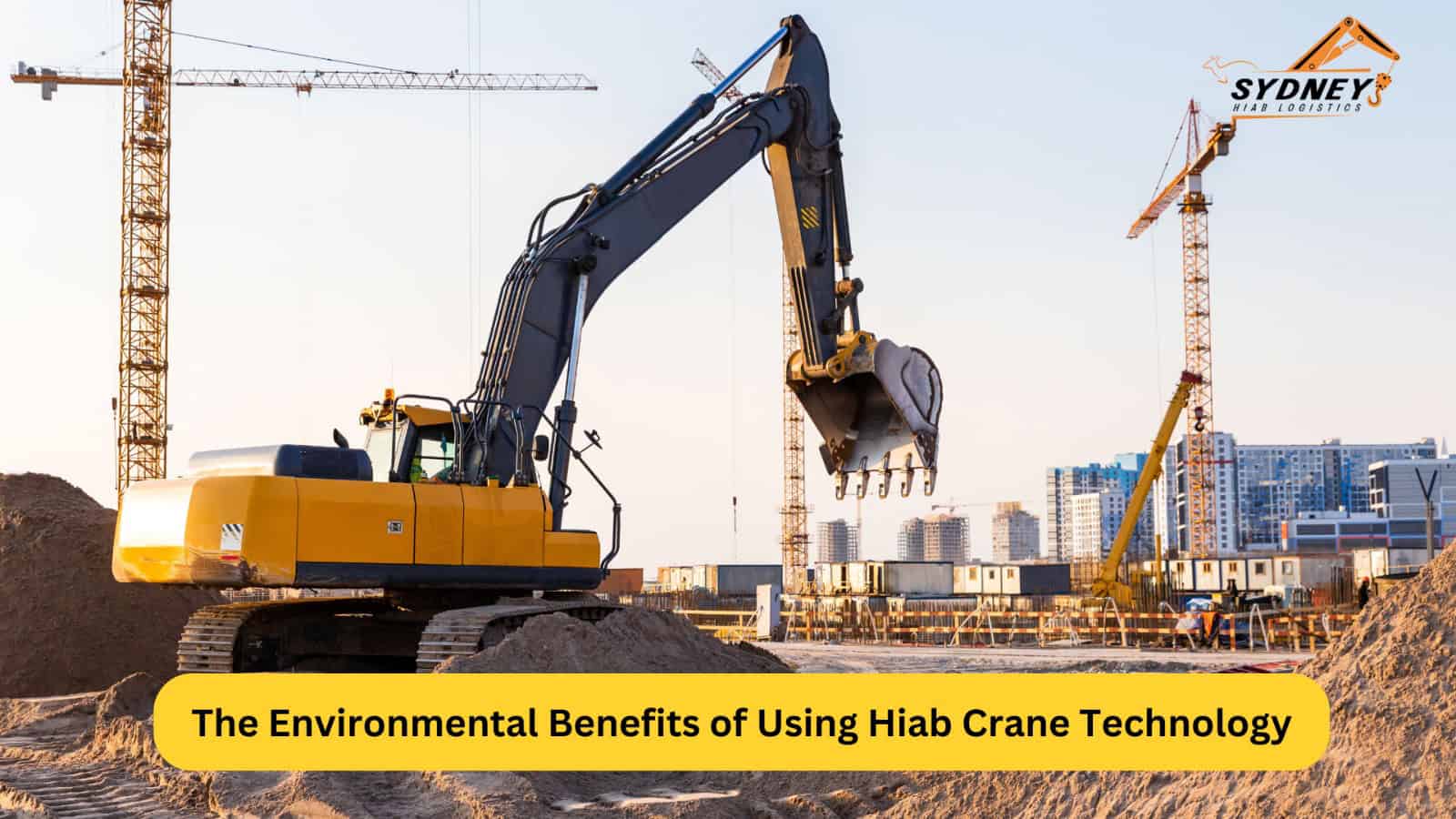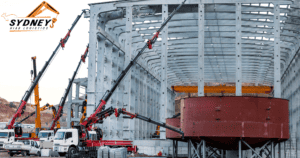How can we transform transportation to protect our planet for future generations? Enter Hiab crane technology. With its potential to revolutionise how we move goods while minimising harm to the environment, this innovative solution sparks curiosity. How exactly does it work, and what benefits does it offer? Join us on a journey to uncover the answers. From reducing carbon emissions to enhancing efficiency, Hiab crane technology holds the promise of a greener, more sustainable future. Let’s start on this exploration together and discover how Hiab cranes can play a pivotal role in shaping a healthier world for all.
Decreased Traffic Congestion
Sustainable transportation also offers the benefit of decreased traffic congestion in urban areas. As populations continue to grow, cities around the world are facing increasing challenges related to traffic congestion. This not only leads to frustration for commuters but also has negative impacts on air quality and overall quality of life. By promoting sustainable transportation options, such as public transit, biking, and walking, cities can alleviate traffic congestion and create more efficient transportation systems. Public transit, in particular, has the potential to move a large number of people in a relatively small amount of space, reducing the number of individual cars on the road and easing congestion. Additionally, investments in bike lanes and pedestrian infrastructure can encourage more people to choose these alternative modes of transportation, further reducing the number of vehicles on the road.
In addition to reducing congestion, sustainable transportation can also lead to improved traffic flow and reduced travel times. By prioritising public transit and alternative modes of transportation, cities can create more efficient transportation networks that benefit all commuters. This not only reduces the time spent in traffic but also lowers fuel consumption and emissions associated with idling vehicles. By embracing sustainable transportation options and investing in infrastructure that supports these modes of travel, cities can create more livable and vibrant urban environments for residents and visitors alike.
Preservation of Natural Landscapes
Sustainable transportation plays a crucial role in the preservation of natural landscapes and the protection of biodiversity. Traditional transportation infrastructure, such as highways and roads, often leads to habitat fragmentation and the destruction of natural ecosystems. This can have devastating impacts on wildlife populations and the overall health of the environment. By promoting sustainable transportation options, such as public transit and biking, cities and communities can reduce the need for expansive road networks and minimise the impact on natural landscapes. Public transit, in particular, can help to concentrate development in urban areas, reducing the need for sprawling infrastructure that encroaches on natural habitats. Additionally, investments in bike lanes and pedestrian infrastructure can create more connected and walkable communities, further reducing the need for extensive road networks that disrupt natural landscapes.
Furthermore, sustainable transportation can lead to the preservation of natural landscapes by reducing the demand for new infrastructure projects. By prioritizing public transit and alternative modes of transportation, cities can limit the need for new roads and highways that would otherwise encroach on undeveloped land. This not only protects natural habitats but also preserves the scenic beauty of landscapes for future generations to enjoy. By embracing sustainable transportation options and investing in infrastructure that supports these modes of travel, cities and communities can play a vital role in the preservation of natural landscapes and the protection of biodiversity.
Efficient Use of Resources
Sustainable transportation promotes the efficient use of resources, leading to cost savings and environmental benefits. Traditional modes of transportation, such as cars and airplanes, are highly resource-intensive, requiring significant amounts of fuel and materials to operate. By embracing sustainable transportation options, such as public transit and biking, individuals and communities can reduce the overall demand for resources and minimise the environmental impact of transportation. Public transit, for example, can carry a large number of passengers at once, making more efficient use of fuel and reducing the overall energy consumption associated with transportation. Additionally, investments in bike lanes and pedestrian infrastructure can encourage more people to choose these alternative modes of transportation, further reducing the demand for resources and minimising the environmental impact.
Furthermore, sustainable transportation can lead to cost savings for individuals and communities. Public transit, for example, is often more cost-effective than owning and operating a personal vehicle, leading to potential savings on fuel, maintenance, and parking. Additionally, biking and walking are virtually cost-free, making them the most affordable modes of transportation. By embracing sustainable transportation options and investing in infrastructure that supports these modes of travel, individuals and communities can realise significant cost savings while also minimising the environmental impact of transportation.
Lower Noise Pollution
Sustainable transportation offers the benefit of lower noise pollution in urban and suburban areas. Traditional modes of transportation, such as cars and airplanes, are major sources of noise pollution, which can have negative impacts on public health and overall quality of life. By promoting sustainable transportation options, such as public transit, biking, and walking, cities and communities can reduce the overall noise levels in urban and suburban areas. Public transit, in particular, can move a large number of people in a relatively small amount of space, reducing the need for individual cars and subsequently lowering the overall noise levels. Additionally, investments in bike lanes and pedestrian infrastructure can encourage more people to choose these alternative modes of transportation, further reducing the noise pollution associated with traditional vehicles.
In addition to reducing noise pollution, sustainable transportation can also lead to more peaceful and enjoyable urban environments. By prioritising public transit and alternative modes of transportation, cities can create more walkable and bike-friendly communities that are conducive to outdoor activities and social interaction. This not only improves the overall quality of life for residents but also enhances the desirability of urban and suburban areas. By embracing sustainable transportation options and investing in infrastructure that supports these modes of travel, cities and communities can create more livable and vibrant environments that are free from excessive noise pollution.
Reduced Waste Generation
Sustainable transportation promotes reduced waste generation and encourages more sustainable consumption patterns. Traditional modes of transportation, such as cars and airplanes, are major sources of waste, from the production and disposal of vehicles to the packaging and consumption of fuel. By embracing sustainable transportation options, such as public transit, biking, and walking, individuals and communities can reduce the overall waste generated by transportation and minimise the environmental impact. Public transit, for example, can carry a large number of passengers at once, reducing the need for individual cars and subsequently lowering the overall waste associated with transportation. Additionally, investments in bike lanes and pedestrian infrastructure can encourage more people to choose these alternative modes of transportation, further reducing the waste generated by traditional vehicles.
Furthermore, sustainable transportation can lead to more sustainable consumption patterns and a reduced reliance on single-use items. Public transit, for example, encourages individuals to share resources and reduce their overall consumption of fuel and materials. Additionally, biking and walking promote a more active and sustainable lifestyle, leading to less reliance on cars and the associated waste generated. By embracing sustainable transportation options and investing in infrastructure that supports these modes of travel, individuals and communities can reduce their overall waste generation and minimise the environmental impact of transportation.
Enhanced Safety Measures
Sustainable transportation offers the benefit of enhanced safety measures for individuals and communities. Traditional modes of transportation, such as cars and motorcycles, are associated with a higher risk of accidents and injuries, leading to negative impacts on public health and overall safety. By promoting sustainable transportation options, such as public transit, biking, and walking, cities and communities can create safer and more secure transportation systems. Public transit, in particular, is often equipped with safety features and protocols that prioritise the well-being of passengers, reducing the risk of accidents and injuries. Additionally, investments in bike lanes and pedestrian infrastructure can create safer environments for individuals who choose these alternative modes of transportation, further reducing the risk of accidents and injuries.
In addition to enhancing safety measures, sustainable transportation can also lead to more active and healthy lifestyles for individuals. By prioritising public transit and alternative modes of transportation, cities can encourage more physical activity and reduce the reliance on sedentary modes of travel. This not only improves the overall health and well-being of individuals but also reduces the risk of chronic diseases associated with a lack of physical activity. By embracing sustainable transportation options and investing in infrastructure that supports these modes of travel, cities and communities can create safer and more active environments that prioritize the well-being of residents and visitors alike.
Conservation of Energy
Sustainable transportation promotes the conservation of energy and the reduction of overall energy consumption. Traditional modes of transportation, such as cars and airplanes, are highly energy-intensive, requiring significant amounts of fuel and resources to operate. By embracing sustainable transportation options, such as public transit, biking, and walking, individuals and communities can reduce the overall energy consumption associated with transportation and minimise the environmental impact. Public transit, for example, can carry a large number of passengers at once, making more efficient use of energy and reducing the overall energy consumption. Additionally, investments in bike lanes and pedestrian infrastructure can encourage more people to choose these alternative modes of transportation, further reducing the demand for energy and minimising the environmental impact.
Furthermore, sustainable transportation can lead to the conservation of energy and the promotion of more sustainable energy sources. Public transit, for example, is increasingly powered by renewable energy sources, such as solar and wind, reducing the reliance on fossil fuels and lowering overall energy consumption. Additionally, the use of electric vehicles and alternative fuel sources in public transit and commercial vehicles further reduces the demand for traditional energy sources and minimises the environmental impact. By embracing sustainable transportation options and investing in infrastructure that supports these modes of travel, individuals and communities can conserve energy and promote more sustainable energy sources for transportation.
Minimal Disruption to Surrounding Areas
Sustainable transportation minimises disruption to surrounding areas and promotes more harmonious coexistence with the natural environment. Traditional modes of transportation, such as cars and highways, often lead to the destruction of natural habitats and the fragmentation of ecosystems. By promoting sustainable transportation options, such as public transit, biking, and walking, cities and communities can reduce the overall disruption to surrounding areas and minimise the environmental impact of transportation. Public transit, in particular, can concentrate development in urban areas, reducing the need for sprawling infrastructure that encroaches on natural habitats. Additionally, investments in bike lanes and pedestrian infrastructure can create more connected and walkable communities, further reducing the disruption to surrounding areas.
Furthermore, sustainable transportation can lead to more harmonious coexistence with the natural environment and the preservation of scenic landscapes. By prioritising public transit and alternative modes of transportation, cities can create more sustainable transportation networks that minimise the impact on surrounding areas. This not only protects natural habitats but also preserves the scenic beauty of landscapes for future generations to enjoy. By embracing sustainable transportation options and investing in infrastructure that supports these modes of travel, cities and communities can minimise disruption to surrounding areas and promote more harmonious coexistence with the natural environment.
Contribution to Sustainable Development
Sustainable transportation plays a crucial role in contributing to sustainable development and creating more resilient and vibrant communities. Traditional modes of transportation, such as cars and airplanes, are often associated with unsustainable development patterns and the degradation of natural resources. By promoting sustainable transportation options, such as public transit, biking, and walking, cities and communities can create more sustainable and resilient transportation systems that support the needs of residents and visitors alike. Public transit, in particular, can provide equitable access to transportation for all individuals, reducing the reliance on personal vehicles and promoting more sustainable development patterns. Additionally, investments in bike lanes and pedestrian infrastructure can create more connected and walkable communities, further supporting sustainable development goals.
Furthermore, sustainable transportation can lead to more vibrant and livable communities that prioritize the well-being of residents and visitors. By prioritising public transit and alternative modes of transportation, cities can create more walkable and bike-friendly environments that support active and healthy lifestyles. This not only improves the overall quality of life for individuals but also enhances the desirability of urban and suburban areas. By embracing sustainable transportation options and investing in infrastructure that supports these modes of travel, cities and communities can contribute to sustainable development and create more resilient and vibrant communities for future generations to enjoy.
Ready to embrace sustainable transportation with the power of Hiab crane technology? For reliable Hiab crane hiring services, contact us today. Let’s build a greener future together.




